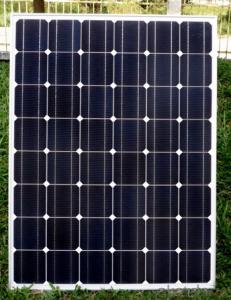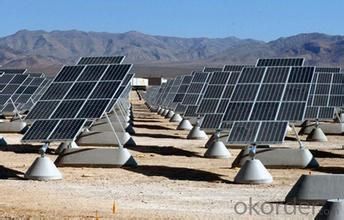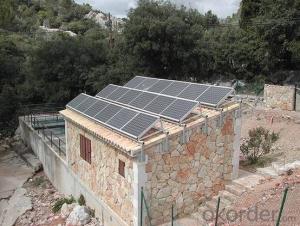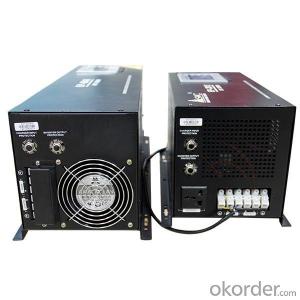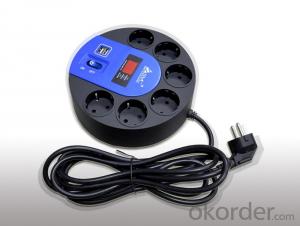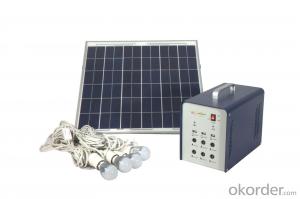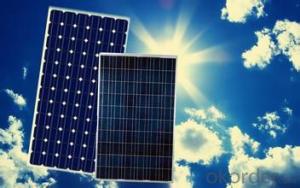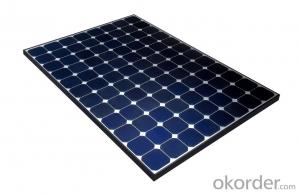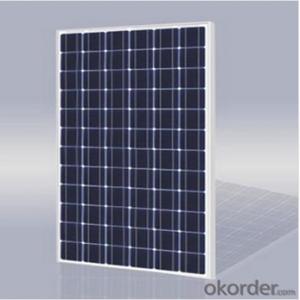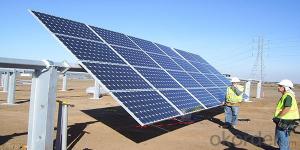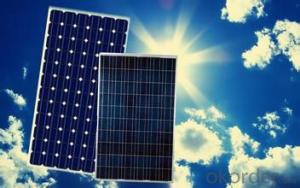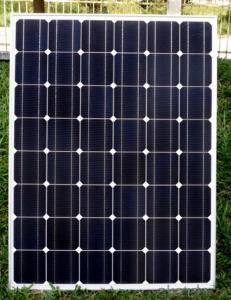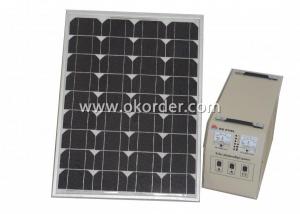Erus Solar Energy Systems 106kw CNBM Monocrystalline Silicon Panel for Home Use
- Loading Port:
- Tianjin
- Payment Terms:
- TT OR LC
- Min Order Qty:
- 45 watt
- Supply Capability:
- 1000 watt/month
OKorder Service Pledge
OKorder Financial Service
You Might Also Like
Specification
106KW CNBM Monocrystalline Silicon Panel for Home Using
Production description
Off-the-grid homes are autonomous; they do not rely on municipal water supply, sewer, natural gas, electrical power grid, or similar utility services. A true off-grid house is able to operate completely independently of all traditional public utility services. The idea has been recently popularized by certain celebrities including Ed Begley, Jr.[1] who stars in Living with Ed[2] television show on the Home & Garden Television (HGTV) network. Actress Daryl Hannahpromotes off-grid living and constructed her home in Colorado according to those principles, as does survival expert and Dual Survival co-star Cody Lundin,[3]who lives in a self-designed, passive solar earth house in the high-desert wilderness of Northern Arizona, collecting rainwater, composting waste, and paying nothing for utilities.[4][5]
This is several times larger than the total world energy consumption, which was 559.8 EJ in 2012.
Electrical power can be generated on-site with renewable energy sources such as solar (particularly with photovoltaics), wind, micro hydro, geothermal; with agenerator or Micro combined heat and power with adequate fuel reserves. Such a system is called a stand-alone power system. In addition, it is possible to simply eliminate electric power such as in Old Order Amish and Old Order Mennonite communities.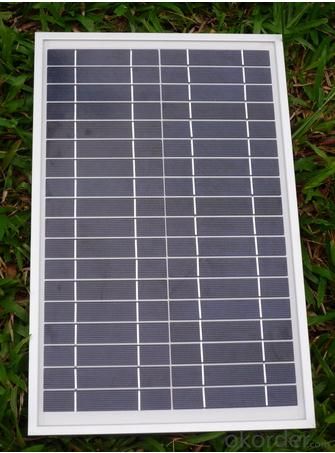
Feature
1.High conversion efficiencies resulting in superior power output performance.
2.Outstanding power output even in low light or high temperature conditions
3.Optimized design for ease of soldering and lamination
Physical characteristic
1. Rigorous quality control meets the highest international standards.
2. High-transmissivity low-iron tempered glass, strong aluminium frame.
3. Using UV-resistant silicon.
4. IS09001/14001/CE/TUV/UL
Packaging
26pcs in one carton 6pallets in 20foot container 14pallets in 40 foot container.
- Q: How do solar energy systems impact roof maintenance and repairs?
- Solar energy systems can have both positive and negative impacts on roof maintenance and repairs. On one hand, the installation of solar panels can provide an additional layer of protection to the roof, shielding it from the elements and prolonging its lifespan. However, roof maintenance becomes more challenging as solar panels need to be temporarily removed or adjusted during inspections or repairs. Additionally, the installation process itself may cause minor damage to the roof, which should be promptly addressed to prevent any long-term issues. Overall, proper planning, regular inspections, and timely repairs are crucial to ensure the optimal performance of both the solar energy system and the roof.
- Q: How do solar energy systems impact the overall energy independence of a building?
- Solar energy systems can have a significant impact on the overall energy independence of a building. By harnessing the power of the sun, these systems generate clean and renewable energy, reducing the dependency on traditional fossil fuel sources. This shift towards solar energy allows buildings to become more self-sufficient and less reliant on the grid for their energy needs. One key aspect of solar energy systems is their ability to generate electricity. By installing solar panels on rooftops or in open spaces, buildings can produce their own electricity, reducing the need to purchase it from external sources. This not only lowers energy costs but also provides a reliable source of power that is not subject to price fluctuations or supply disruptions. With a properly sized solar system, a building can potentially meet all or a significant portion of its electricity demand. Moreover, solar energy systems often come with storage options such as batteries, allowing excess electricity generated during the day to be stored for use at night or during cloudy periods. This feature enhances the resilience of the building's energy supply and further reduces reliance on the grid. In addition to electricity, solar energy systems can also contribute to the heating and cooling needs of a building. Solar thermal systems use the sun's energy to heat water or air, which can then be used for various purposes such as space heating, hot water supply, or even air conditioning. By utilizing solar thermal technology, buildings can reduce their reliance on traditional heating and cooling systems powered by fossil fuels or electricity. Furthermore, solar energy systems have a positive environmental impact. By replacing conventional energy sources with clean and renewable solar energy, buildings can significantly reduce their carbon footprint and contribute to mitigating climate change. This shift towards clean energy also helps in reducing air and water pollution associated with traditional energy generation methods. Overall, solar energy systems play a crucial role in enhancing the energy independence of a building. By generating electricity and providing heating and cooling options through clean and renewable solar energy, buildings can reduce their reliance on external energy sources, decrease costs, enhance resilience, and contribute to a more sustainable future.
- Q: Can solar energy systems be used in powering banks or financial institutions?
- Certainly, solar energy systems have the capability to power banks and financial institutions. Actually, numerous banks and financial institutions across the globe are adopting solar energy systems as a viable and economical solution for their power requirements. Solar energy systems comprise of photovoltaic (PV) panels that convert sunlight into electricity. These panels can be installed on the rooftops or open spaces surrounding banks and financial institutions. The electricity generated can then be utilized to power various operations within these institutions, such as lighting, air conditioning, computers, ATMs, and other electronic devices. There are several advantages to utilizing solar energy systems for banks and financial institutions. Firstly, they provide a consistent and uninterrupted source of electricity, reducing reliance on the conventional power grid. This ensures continuous operations and minimizes the risk of power outages, which is crucial for financial institutions that require constant access to their systems. Furthermore, the use of solar energy aids in reducing the carbon footprint of banks and financial institutions, contributing to environmental sustainability. By utilizing renewable energy, they can significantly decrease greenhouse gas emissions and combat climate change. This aligns with the growing focus on corporate social responsibility and sustainable practices among businesses. Additionally, solar energy systems offer long-term cost benefits. Although the initial installation cost may be higher compared to traditional energy sources, solar systems have low operating and maintenance costs. Over time, the savings on electricity bills can be substantial, enabling banks and financial institutions to allocate those funds towards other investments or initiatives. Moreover, the installation of solar panels can enhance the reputation and brand image of banks and financial institutions. By visibly demonstrating their commitment to renewable energy, they can attract environmentally conscious customers and investors who value sustainable practices. In conclusion, solar energy systems are highly suitable for powering banks and financial institutions, providing a reliable, sustainable, and cost-effective solution. By utilizing solar energy, these institutions can fulfill their power requirements while reducing their environmental impact and bolstering their reputation in the market.
- Q: Do solar energy systems require a backup generator?
- No, solar energy systems do not necessarily require a backup generator. Solar energy systems primarily rely on sunlight to generate electricity, so as long as there is sufficient sunlight, they can produce power. However, it is important to note that solar energy systems are typically interconnected to the electrical grid, allowing excess energy to be fed back into the grid during times when the solar panels produce more electricity than is being used. This allows for a credit or compensation from the utility company, which can offset the cost of electricity when the solar panels are not generating enough power. In situations where a solar energy system is off-grid and not connected to the electrical grid, a backup generator or energy storage system, such as batteries, may be necessary to provide power during times when there is insufficient sunlight. This ensures a continuous power supply even in the absence of sunlight. Ultimately, the need for a backup generator depends on the specific setup and requirements of the solar energy system.
- Q: Can solar energy systems be used for transportation?
- Yes, solar energy systems can be used for transportation. Solar energy can be harnessed to power different types of vehicles, including cars, buses, boats, and even airplanes. Solar-powered vehicles use photovoltaic (PV) cells to convert sunlight into electricity, which can then be stored in batteries or used directly to power the vehicle's electric motor. Solar panels can be installed on the roof, hood, or any other suitable surface of the vehicle to capture sunlight and generate electricity. While solar-powered transportation is still relatively limited in terms of range and speed compared to traditional fossil fuel-powered vehicles, advancements in solar technology are continuously improving the efficiency and performance of these systems. Furthermore, solar energy can also be utilized in transportation infrastructure, such as solar-powered charging stations for electric vehicles, providing a sustainable and renewable alternative to traditional energy sources.
- Q: Can solar energy systems be used in powering printing presses or publishing houses?
- Yes, solar energy systems can be used to power printing presses or publishing houses. Solar energy is a renewable and sustainable source of power that can be harnessed through the use of solar panels and converted into electricity. This electricity can then be used to operate various equipment, including printing presses, computers, and other machinery commonly found in publishing houses. Installing solar panels on the rooftops of printing presses or publishing houses can generate a significant amount of electricity, reducing the reliance on traditional energy sources and lowering utility costs. The size of the solar energy system required will depend on the energy demand of the specific facility, but it is entirely feasible to power printing presses and publishing houses with solar energy. Additionally, solar energy systems can provide a reliable and consistent source of power, as long as there is sufficient sunlight available. This can be particularly beneficial in regions with abundant sunlight, as the printing presses or publishing houses can potentially become self-sufficient in terms of electricity generation. Moreover, utilizing solar energy systems for powering printing presses and publishing houses can have environmental benefits. Solar power is a clean energy source that produces no greenhouse gas emissions or air pollution during operation. By switching to solar energy, printing presses and publishing houses can significantly reduce their carbon footprint and contribute to a more sustainable future. In conclusion, solar energy systems can indeed be used to power printing presses or publishing houses. They offer a renewable, sustainable, and environmentally friendly alternative to traditional energy sources, while also providing the potential for cost savings and energy independence.
- Q: What are the benefits of using solar energy systems?
- There are several benefits of using solar energy systems. Firstly, they are a renewable source of energy, meaning that they can generate electricity without depleting natural resources. Secondly, solar energy systems produce clean energy, as they do not emit any greenhouse gases or pollutants during operation, contributing to a healthier environment. Additionally, solar energy systems can help reduce electricity bills, as they provide a cost-effective way of generating electricity for homes or businesses. Finally, installing solar panels can also increase the value of a property and create job opportunities in the renewable energy sector.
- Q: Do solar energy systems work at night?
- Solar energy systems do not work at night because they rely on sunlight to generate electricity. Solar panels convert sunlight into electricity through the photovoltaic effect, where photons from the sun's rays knock electrons loose from atoms, creating a flow of electricity. Without sunlight, there is no source of energy to power the system. However, it is worth mentioning that some solar energy systems can store excess energy produced during the day in batteries, which can be used to power appliances or lights at night.
- Q: What are the advantages of solar energy systems?
- Solar energy systems offer several benefits. To begin with, solar energy is an endless source of power, relying on the sun's continuous existence. This stands in stark contrast to finite fossil fuels, which are depleting rapidly. Furthermore, solar energy is environmentally conscious. Unlike fossil fuels, solar energy systems do not release harmful greenhouse gases or pollutants that contribute to climate change and air pollution. This makes solar energy a clean and sustainable alternative that aids in reducing our carbon footprint and countering the adverse effects of global warming. Moreover, solar energy systems can significantly decrease electricity expenses. Once the initial investment in solar panels is made, the cost of harnessing solar energy remains relatively low. Solar energy is essentially free, with the only expenses being equipment maintenance and occasional repairs. This can result in substantial long-term savings on energy bills, especially considering the continuous rise in traditional electricity costs. Additionally, solar energy systems promote energy independence. By generating your own electricity, you become less reliant on utility companies and the fluctuating prices of fossil fuels. This independence enhances energy security, as solar energy systems are not susceptible to supply disruptions or price fluctuations caused by geopolitical tensions or natural disasters. Lastly, the installation of solar energy systems stimulates local economies and job creation. The solar industry has experienced significant growth, leading to the creation of numerous jobs in manufacturing, installation, and maintenance. This not only boosts the economy but also provides employment opportunities in a rapidly expanding sector. In conclusion, the benefits of solar energy systems are manifold. From being a renewable and environmentally friendly power source to reducing electricity expenses, providing energy independence, and generating jobs, solar energy proves to be a viable and sustainable solution for our energy needs.
- Q: What is the impact of shading on the performance of solar panels?
- Shading has a significant impact on the performance of solar panels. When any part of a solar panel is shaded, it reduces the amount of sunlight that reaches the cells, resulting in a decrease in energy production. This is because solar panels operate by converting sunlight into direct current (DC) electricity through the photovoltaic effect. When a solar panel is partially shaded, it creates what is known as a "hotspot effect." This occurs when shaded cells within a panel become a high-resistance pathway for the flow of electricity, leading to a localized increase in temperature. This increased heat can degrade the performance of the entire panel and reduce its overall efficiency. Furthermore, shading also affects the panel's overall voltage and current output. Solar panels are typically connected in series to increase the output voltage. However, if even a single panel is shaded, it can significantly reduce the performance of the entire series-connected string. This is because the shaded panel acts as a bottleneck, limiting the current flow through the entire string. To mitigate the impact of shading, various solutions can be implemented. One common approach is to use bypass diodes, which allow the current to flow around the shaded cells, preventing the hotspot effect. By incorporating bypass diodes, the energy loss due to shading can be minimized, ensuring that the rest of the solar panel continues to operate efficiently. Additionally, proper design and placement of solar panels can also help reduce the effects of shading. Installing solar panels in areas with minimal obstructions or shadows, such as rooftops or open fields, can maximize their exposure to sunlight. Regular maintenance, including trimming nearby trees or vegetation that may cast shadows, is also important to ensure optimal performance. In conclusion, shading has a significant impact on the performance of solar panels, leading to reduced energy production and efficiency. Understanding and addressing shading issues through the use of bypass diodes and careful installation can help maximize the output and effectiveness of solar panel systems.
Send your message to us
Erus Solar Energy Systems 106kw CNBM Monocrystalline Silicon Panel for Home Use
- Loading Port:
- Tianjin
- Payment Terms:
- TT OR LC
- Min Order Qty:
- 45 watt
- Supply Capability:
- 1000 watt/month
OKorder Service Pledge
OKorder Financial Service
Similar products
Hot products
Hot Searches
Related keywords
